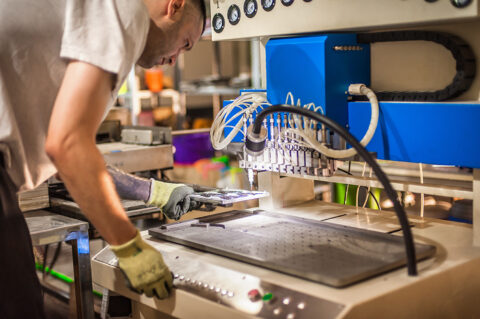Opening
This week in U.S. manufacturing tells a story of contrasts. On one hand, output stalled and factory employment slipped to its lowest point in five years. On the other hand, companies like GE Appliances and Apple unveiled multi-billion-dollar investments that will anchor the next generation of American production. It’s a reminder that while the day-to-day numbers may fluctuate, the long arc of reshoring and industrial renewal continues to bend in America’s favor. We are still in the first innings of a 20–30 year transformation, and the long tail of small and medium-sized manufacturers remains at the heart of it.
Main Stories
Flat Output Signals Ongoing Headwinds
The Story: July’s data brought more sobering news. Industrial production pulled back slightly, and U.S. factory output registered zero growth. The S&P Global Manufacturing PMI slipped below 50, signaling contraction, while factory employment fell to its lowest level in five years.
Why It Matters: For small and mid-sized manufacturers, this environment reflects real pressure—slower orders, tighter margins, and higher costs. The challenge isn’t lack of capability; it’s navigating demand fluctuations and cost burdens while trying to keep their teams intact.
The Bigger Picture: Short-term contractions are part of the turbulence of transition. Despite these setbacks, the strategic reshoring wave remains intact. These businesses are in the fight not just for their survival, but for America’s manufacturing future.
GE and Apple Double Down on U.S. Production
The Story: GE Appliances announced a $3 billion investment to bring appliance production from China and Mexico back into five U.S. states, creating more than 1,000 new jobs. Meanwhile, Apple committed $600 billion over four years to expand domestic supply chains for glass, rare earth magnets, and silicon components. The White House also highlighted a surge of reshoring investments from Hyundai, John Deere, Corning, Merck, and others.
Why It Matters: These announcements translate into real opportunities for smaller manufacturers—suppliers, fabricators, and service providers—who make the parts and components that feed into larger production systems.
The Bigger Picture: Reshoring on this scale isn’t just headline-making—it reshapes the playing field. The American model of distributed capacity is being reinforced, opening doors for thousands of businesses to connect and collaborate.
Machinery Orders Point to Long-Term Confidence
The Story: U.S. Manufacturing Technology Orders climbed to $429 million in June, up 9% from May and nearly 14% higher than last year. Aerospace, power transmission, and primary metals sectors saw especially strong demand.
Why It Matters: Even in the face of flat output, companies are investing in advanced machinery and technology. Small manufacturers upgrading their capabilities signal confidence in long-term demand and a desire to stay competitive.
The Bigger Picture: These capital investments are laying the foundation for a stronger, more resilient industrial base. Technology is not replacing human expertise—it’s augmenting it, making American manufacturers more capable and adaptive.
Federal Push for Critical Minerals
The Story: The Department of Energy proposed nearly $1 billion in funding to boost U.S. capacity in critical minerals, battery production, rare earth processing, and recycling.
Why It Matters: This kind of support creates opportunities for smaller firms in mining equipment, materials processing, and recycling—industries where distributed innovation and capacity matter most.
The Bigger Picture: Critical minerals are at the core of strategic competition with China. Diversifying supply chains is not just about economics—it’s about national security.
Labor Market Pain Hits Early-Career Workers
The Story: Layoffs are rising, with entry-level workers and recent graduates bearing the brunt. Manufacturing is one of the hardest-hit sectors, raising concern about the pipeline of future skilled workers.
Why It Matters: Workforce development is about more than training programs. If new workers can’t find stable roles, the next generation of tradespeople and technicians may never enter the field.
The Bigger Picture: America’s manufacturing renaissance will require a strong workforce. Stable business conditions for small manufacturers are what allow them to hire, train, and retain the next wave of skilled talent.
Around the Horn
- Policy Framing: White House touts its “Made in America Agenda” as fueling the manufacturing boom.
- Incentive Impact: Multiple firms credit federal incentives in decisions to expand U.S. production.
- Regional Spread: Reshoring investments are geographically distributed—GE’s five-state expansion and Apple’s multi-region supply chain projects show this is a nationwide movement.
Looking Ahead
This week underscored the duality of American manufacturing: near-term headwinds in production and jobs, alongside long-term tailwinds of investment, technology adoption, and strategic reshoring. The renaissance isn’t linear—but it’s real. The task ahead is ensuring that small manufacturers, who make up 99% of the sector, are positioned to seize these opportunities.
Next week, we’ll be watching closely for updates on semiconductor reshoring initiatives and new policy proposals targeting supply chain resilience. Until then, let’s keep leaning into the American way of building—together, in community, with resilience and purpose.




